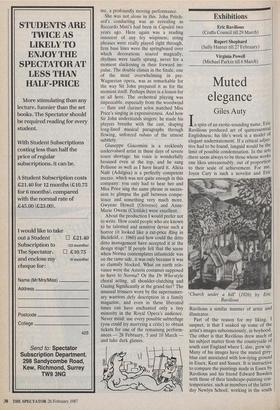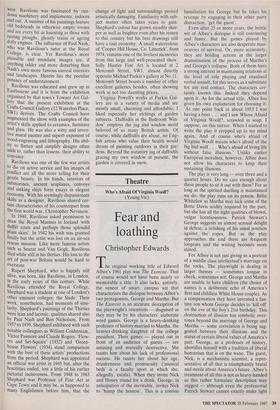Exhibitions
Eric Ravilious (Crafts Council till 29 March) Rupert Shephard (Sally Hunter till 27 February) Virginia Powell (Michael Parkin till 6 March)
Muted elegance
Giles Auty
In spite of an exotic-sounding name, Eric Ravilious produced art of quintessential Englishness; his life's work is a model of elegant understatement. If a critical adjec- tive had to be found, languid would be the limit of possible condemnation. In the arts .there seem always to be those whose works one likes unreasonably, out of proportion to their scale of achievement. For me, Joyce Cary is such a novelist and Eric `Church under a hill' (1926) by Eric Ravilious Ravilious a similar manner of artist and illustrator.
Part of the reason for my liking, I suspect, is that I soaked up some of the artist's images subconsciously, in boyhood. The other is that Ravilious drew much of his subject matter from the countryside of south east England where I, also, grew up. Many of his images have the muted grey- blue cast associated with low-lying ground in Essex, Kent and Sussex. It is instructive to compare the paintings made in Essex by Ravilious and his friend Edward Bawden with those of their landscape-painting con- temporaries, such as members of the latter- day Newlyn School, working in the south west. Ravilious was fascinated by run- down machinery and implements, indoors and out. A number of his paintings feature old bedsteads in otherwise empty rooms and are every bit as haunting as those with rusting ploughs, ghostly trains or ageing dolly engines. The influence of Paul Nash, who was Ravilious's tutor at the Royal College, is clear. Yet Ravilious's more plausible and mundane images are, if anything odder and more disturbing than Nash's own more famous surreal interiors and landscapes. Herein lies the peculiar potency of understatement. Ravilious was educated and grew up in Eastbourne and it is from the exhibition Organised by that town's Towner Art Gal- lery that the present exhibition at the Crafts Council Gallery (12 Waterloo Place, SW1) derives. The Crafts Council have augmented the show with examples of the artist's skills applied to ceramics, furniture and glass. He was also a witty and inven- tive mural painter and superb exponent of Wood-engraving and lithography. His abil- ity to flatten and simplify designs often adds to, rather than lessens, their ability to convince.
Ravilious was one of the few war artists to die on active service and his images of conflict are all the more telling for their gentle beauty. In his hands, interiors of submarines, ancient seaplanes, convoys and sinking ships form essays in elegant economy. With his seemingly dispassionate skills as a designer, Ravilious shared cer- tain characteristics of his counterpart from the first world war, Christopher Nevinson.
In 1940, Ravilious asked permission to draw the Royal Marines in Iceland 'with duffel coats and perhaps those splendid plum skies'. In 1942 his wish was granted finally but the artist was lost on an air-sea rescue mission. Like more famous artists such as Seurat and Van Gogh, Ravilious died while still in his thirties. His loss to the art of post-war Britain would be hard to overstate.
Rupert Shephard, who is happily still alive, was born, like Ravilious, in London, In the early years of this century. While Ravilious attended the Royal College, Shephard was a student at one of London's other eminent colleges: the Slade. Their work, nonetheless, had moments of simi- larity. Shephard's paintings of the Thirties were lean and laconic, qualities shared also by Paul Nash and Ben Nicholson. From 1937 to 1939, Shephard exhibited with such notable colleagues as William Coldstream, Victor Pasmore and Claude Rogers. 'Flow- ers and Set-Square' (1932) and 'Green- house Flowers' (1934) stand comparison with the best of these artists' productions from the period. Shephard was appointed an official war artist in 1945 but, after the hostilities ended, lost a little of his earlier pictorial incisiveness. From 1948 to 1963 Shephard was Professor of Fine Art at Cape Town and it may be, as happened to many Englishmen before him, that the change of light and surroundings proved artistically damaging. Familiarity with sub- ject matter often takes years to gain. Shephard's colour has grown steadily shar- per as well as brighter even after his return to this country but his best drawings still have a taut economy. A small watercolour of 'Cooper Hill House, Co. Limerick', from 1974, remains one of the liveliest memories from this large and well-presented show. Sally Hunter Fine Art is located at 2 Motcomb Street, SW1, almost directly opposite Michael Parkin's gallery at No.11. Motcomb Street boasts a number of other excellent galleries besides, often showing work at not too daunting prices.
Virginia Powell's works at Parkin Gal- lery are in a variety of media and are mostly small, charming and affordable. I liked especially her etchings of garden subjects. 'Daffodils in the Bedroom Win- dow' employs the jug and window motif beloved of so many British artists. Of course, while daffodils are about, no Eng- lish artists who value their health would dream of painting outdoors in their gar- dens. Beyond the statutory jug of daffodils gracing my own window at present, the garden is covered in snow.



















































 Previous page
Previous page